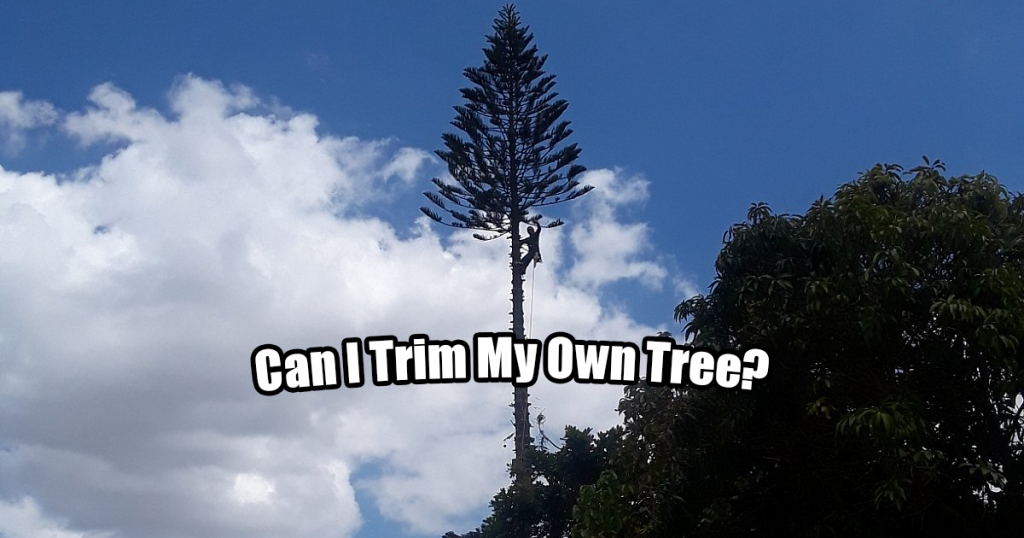
If you want to ensure that your tree is as healthy as possible – to really see it thrive – then you need to trim it from time to time. At the same time, trimming trees can often be a practical consideration that ensures you stay friendly with the neighbors and don’t lose half your garden!
As your tree grows out of control, it not only blocks paths and scratches against windows: it also struggles to get light. Each one of those leaves is like a little solar panel that is designed to soak up the sun’s rays and turn them into useable energy for the tree. If said tree is badly overgrown, then those leaves won’t all get the same amount of light: some of the branches are going to block others. This can cause issues.
So, what do you do if your tree is in need of a trim? Should you attempt this job yourself? Or is it a gig that is best left to the professionals? In this post, we will attempt to explore the answer to that question.
What You Need to Know
It is certainly possible to trim your own trees, and with the right expertise and tools, this is something most people can have a go at.
With that said, it’s also a little more complicated than many people may at first realize. This is because trimming a tree can cause more harm than good if you get it wrong: you can end up hurting the tree for example, or even causing injury – these are sharp tools and big heavy structures after all!
If you have access to a service that is able to cut your tree, then that should be the first option for most people. This will save you a lot of work and stress, but it will also ensure the job is done to the highest possible standard – thus avoiding any serious damage to your property. This can also reduce the risk of injury – which is always preferable!
Either way, we have the information and advice you need below.
Wondering if you can handle your tree trimming on your own? We’d be happy to help you decide!
The Types of Trees
Different types of trees require different levels of care. If you’re in Florida, then you may be dealing with one of the following common trees:
- Red maple
- Loblolly pine
- Douglas fir
- Quaking aspen
- Sugar maple
- Balsam fir
- Flowering dogwood
- Lodgepole pine
- White oak
Of course, there are many more!
Smaller trees are of course easier to trim. This is for several reasons: a small tree has less to trim, because it isn’t as expansive. This also means there is less danger involved, as you won’t need to climb up the tree while wielding sharp tools. And the tools themselves won’t need to be so sharp – because the branches aren’t as thick. With a smaller tree, you can stand at the bottom, cut away, and not worry about large branches falling and hurting someone.
What You Will need
For a small tree, you will need a pruning tool. Make sure that this is very sharp and very clean. You might be surprised to learn that sharper tools are actually less dangerous! The reason for this, is that a blunt tool will require a lot more effort to cut. That in turn means you’re pushing harder and you are more likely to slip and cut yourself.
Conversely, a sharp tool will cut straight through without you having to provide too much force.
There are a number of tools you can use to do this job, depending on the thickness of the tree. A tree looper or a pruner will work well for those thinner branches, and for even smaller trees, you can make do with pruning sheers. However, if you are cutting large, thick branches, you may need a pole chainsaw. These can also be used to cut down entire trees.
Again, this is a reason to think twice before trimming very large trees: as you will be wielding powerful and potentially dangerous tools. Chainsaws are also things that not everyone owns, meaning that you may need to invest a fair amount of money to do the job. At this point, why not just pay someone else to handle the work for you?
You may also need a means to get high enough up into the tree. You can either use a ladder, or you can attach yourself to the tree using a harness and a carabiner. It’s often a good idea to have someone nearby to hold the ladder for you in case you fall.
In general, having a second person to hand is a good idea as they can help you stay steady and they can call for help should you need it.
Experience Level
Consider your experience level. Is this something you’ve done before? Have you worked on similar jobs? Do you already own the tools and are you familiar with them?
This is a time for honest reflection. While you might like the idea of saving money, the truth is that it is usually better to avoid jobs you aren’t prepared for. This is not the time to learn how to use new tools!
If you’ve never trimmed a tree before and you’re not feeling confident – call for help.
Safety Precautions
Correct clothing is important for this type of work. Thick leather gloves will minimize the risk of injury – not only from tools but also from pointy branches and broken twigs. Likewise, a thick outer layer can help to prevent scratching (not to mention protecting your clothing!).
Safety goggles should be considered an absolute requirement. It’s not uncommon for splinters or bits of wood to get propelled off when you cut through branches, and this can result in a cut or bleeding eye – be sensible!
Never trim a tree if the weather is bad. If it is very windy or rainy, this will increase your chances of falling or slipping – as well as making it more likely that the branches will fall unpredictably.
Be aware of where you’re cutting. Make sure the ground underneath is clear, make sure you aren’t going to damage any fencing. Look out for power cables overhead.
How to Start
If you still want to go ahead with trimming a SMALL tree on your own, here are some basic pointers to consider.
Make sure you are familiar with the different parts of the branch and the tree. The collar is the swollen part of the tree that is right beneath the branch and the trunk – this looks like the branch has been soldered on! This is a very difficult spot to cut owing to its thickness, so you can avoid cutting there.
The branch ridge is the part that is between the branch and the trunk that is slightly higher. The ridge is the “shoulder” as it were, whereas the collar is the armpit.
You’re going to aim to cut just beyond the branch collar. This is an easier part to cut and it will leave minimal stub. If the branch is thinner than an inch in diameter, then you should cut here at about 45-60 degrees to the bark ridge. If the branch is thicker, it is usual to cut in multiple goes – often three. You can cut the first 10-15 inches up from the branch, then cut halfway into the bottom. Finally move up past the cut and cut into the top of the branch to completely sever the connection.
Before you do any of this though, spend some time familiarizing yourself with the tree and identify which branches you intend to cut and which you’ll leave. Try to leave the branches that are growing at 2 and 10 o’clock angles from the trunk and instead cut the ones that are growing at strange angles. Of course, there may be some “problem” branches that are blocking paths or causing other issues, and those will need to go.
Look for the leader branch. Make sure that you move smaller branches that are competing with this one for light and water. Likewise, you want to remove the water sprouts – the weak and stringy branches that will usually grow in little bunches. They often sit perfectly upright no your trees and they don’t look that great.
One of the most common mistakes is to cut too often and too much. Aim not to cut more than 25% of the tree in one go, and leave a fair amount of time. If you cut too much, this can make the tree week – it will lose too much of its canopy leaving it susceptible. It may grow weak and even die due to the amount of stress.
Likewise, you should avoid cutting the collar. Doing so will prevent the wound from healing properly. This could result in infection and decay.
As you can see, there is plenty to think about. So, make sure you are absolutely confident in your ability before you go ahead and attempt to prune your tree on your own.
